The aesthetic medicine landscape is evolving. Patients in 2024 aren’t just looking for bigger changes, they’re looking for subtle enhancements that no one will be able to pinpoint. This is the era of “undetectable plastic surgery” where patients want to look refreshed, younger, or more confident without anyone suspecting they’ve gone under the knife. From rhinoplasties so refined they look like a natural birthright, to mini-facelifts that leave colleagues guessing if you simply took a great vacation, the desire for subtlety is reshaping patient expectations.
As a plastic surgeon, positioning yourself as an expert in subtle, undetectable transformations is no longer a nice-to-have, it’s becoming a central part of practice branding. Ranking high on Google for “undetectable plastic surgery” and related keywords can put you in front of the right patient demographic those who want cosmetic improvements but fear the stigma of looking “too done.”
This guide is designed for surgeons seeking to strengthen their online presence. The goal: to dominate organic search results for this emerging niche. Let’s dive into how you can leverage SEO to capture patient interest, build trust, and drive more qualified consultations.
Understanding the “Undetectable Era” Trend
The Rise of Subtle Procedures (Celebrity Case Studies)
High-profile celebrities have shaped patient perceptions of what good (and bad) cosmetic surgery looks like. Public figures who once wore their enhancements like badges of honor are now opting for more discreet, refined changes. Consider how frequently tabloids debate Lindsay Lohan’s transformations: Is it just makeup, aging gracefully, or a subtle tweak? The media’s fascination creates a hotbed of patient interest. Similarly, Donatella Versace’s noticeable journey became a cautionary tale, pushing many potential patients to seek finer, more natural results.

Celebrity transformations often spark significant online search interest. Analysis of search volumes reveals the scale of public interest: ‘Kylie Jenner plastic surgery’ leads with over 17,000 monthly searches, followed by ‘Jennifer Aniston plastic surgery’ at 14,000 queries. ‘Madonna plastic surgery’ generates 13,000 monthly searches, while ‘Lindsay Lohan plastic surgery’ sees 6,000 queries and ‘Donatella Versace plastic surgery’ attracts 2,000 searches per month. These substantial search volumes demonstrate the ongoing public fascination with subtle versus obvious transformations.
Integrating discussions around these high-search-volume celebrities, without breaching professional ethics or defamation, can significantly boost your practice’s SEO performance. For instance, analyzing widely covered but subtle changes, particularly in cases like Kylie Jenner’s allegedly minor adjustments to facial contours, can help align your content with what people are actively searching for, while remaining compliant with legal and ethical guidelines. The key is to frame the discussion around general trends and techniques, using these well-documented cases as reference points for educational content.
Impact on Patient Search Behavior
As a result of these cultural shifts, patients are turning to search engines with highly specific queries, creating immediate SEO opportunities. The keyword ‘undetectable facelift‘ currently generates over 1,200 monthly searches with remarkably low competition difficulty, while ‘natural rhinoplasty‘ sees more than 1,000 monthly searches with similarly low competition. This rare combination of significant search volume and low difficulty presents an exceptional opportunity for early movers.
These keywords are still in their growth phase – according to Google Trends, interest in terms like ‘natural-looking plastic surgery’ has risen by approximately 30% over the past three years. The American Society of Plastic Surgeons (ASPS) has noted increasing patient inquiries focusing on subtlety and minimal downtime (ASPS Trends Report). This trend indicates that surgeons who optimize for these terms now will benefit from both immediate visibility and long-term SEO authority as competition inevitably increases. Early content development and optimization around these terms can establish crucial ranking history before these keywords become more competitive.
Current Search Volume Data and Trends
The ‘undetectable plastic surgery’ keyword cluster presents a significant and growing opportunity. Core terms show substantial search volumes with surprisingly low competition:
- ‘Undetectable facelift’: 1,200+ monthly searches, low difficulty
- ‘Natural rhinoplasty’: 1,000+ monthly searches, very low difficulty
- Celebrity-related searches: combined volume of 52,000+ monthly searches (including terms like ‘Kylie Jenner plastic surgery’ at 17,000 searches and ‘Jennifer Aniston plastic surgery’ at 14,000)
These are high-intent searches, often from individuals already committed to the idea of a procedure, just unsure how to proceed or find the right surgeon. The low competition difficulty scores make this an urgent opportunity for early movers in the field.
Leveraging keyword tools like Ahrefs or SEMrush, you’ll also find valuable long-tail variations:
- Location-specific searches: ‘best undetectable facelift in [city]’
- Recovery-focused queries: ‘discreet eyelid surgery recovery tips’
- Result-based searches: ‘natural-looking nose job before and after’
Tracking year-over-year changes shows consistent growth in these terms, indicating a lasting shift in patient preferences rather than a temporary trend. The time to establish authority for these keywords is now, before competition increases and ranking becomes more challenging.

Keyword Research and Analysis
High-Value Search Terms
Begin by identifying core terms. ‘Undetectable facelift’ (1,200+ searches, low difficulty), ‘natural rhinoplasty’ (1,000+ searches, very low difficulty), and ‘natural-looking breast augmentation’ could be primary targets. These search terms come with surprisingly low competition at the moment—a rare opportunity for securing top spots.
The opportunity extends to location-specific keywords. For example, ‘natural rhinoplasty Beverly Hills’ and ‘natural rhinoplasty Los Angeles’ each generate around 20 monthly searches with zero difficulty score: meaning virtually no competition. While these volumes might seem modest, they represent highly qualified leads in prime markets. These location-based searches typically convert at a much higher rate, as they come from patients who are both geographically and procedurally qualified.
Long-Tail Opportunities
Patients often research extensively before consulting. Long-tail keywords matching their exploration phase represent valuable opportunities with minimal competition. For example:
- ‘How to get a natural nose job‘: 20 monthly searches with zero difficulty – a perfect entry point for educational content
- ‘How facelifts became virtually undetectable‘: 60 monthly searches with low difficulty – an ideal topic for in-depth articles
While these search volumes might appear modest, they represent highly engaged users in research mode. By ranking for these questions, you capture early-stage leads who are actively educating themselves and more likely to book consultations once they trust your expertise. The zero to low difficulty scores make these keywords particularly attractive for immediate content development, as you can potentially achieve top rankings with well-optimized, authoritative content.
Geographic Variations
Keyword trends show significant regional variations that create location-specific opportunities. Our data reveals clear patterns:
High-End Markets (Beverly Hills, Los Angeles):
- ‘Natural rhinoplasty Beverly Hills’: 20 monthly searches, zero difficulty
- ‘Natural rhinoplasty Los Angeles’: 20 monthly searches, zero difficulty
- Similar patterns for other affluent areas like Manhattan and Miami Beach
These location-specific searches, while lower in volume, often represent higher-value patients actively seeking premium services. Each geographic market also shows distinct search patterns:
Metropolitan Areas:
- Tend to include terms like ‘undetectable’ and ‘natural-looking’
- Higher search volumes for celebrity-related terms
- More sophisticated procedure-specific terminology
Conservative Markets:
- Focus more on ‘subtle changes’ and ‘minimal procedures’
- Higher search volumes for privacy-related terms
- More emphasis on recovery time and discretion
Tailor your content strategy to match these regional search patterns while maintaining consistent technical SEO best practices across all locations.
Patient Search Intent Analysis
Search intent can be categorized into three main types:
- Educational queries: “What makes a facelift undetectable?” These users seek information and insight, making blog posts, FAQs, and explainer videos ideal.
- Consultation-focused searches: “Best surgeon for undetectable facelift near me.” Here, users are closer to booking, so ensure your contact forms, appointment request buttons, and surgeon credentials are prominently featured.
- Result-based searches: “Before and after subtle rhinoplasty photos.” Image galleries, testimonials, and procedure portfolios will shine here, showing prospects what they can realistically expect.
Competitor Analysis for These Keywords
Use SEO tools to see who currently ranks for these terms. Often, it may be a mix of fellow surgeons, industry magazines (e.g., RealSelf), or general cosmetic surgery directories.
By evaluating competitor pages, you can identify content gaps.
- Are competitors lacking detailed before-and-after galleries optimized for SEO?
- Are their pages missing expert commentary or citing authoritative bodies like The Aesthetic Society (https://www.theaestheticsociety.org/)?
Emphasize what competitors lack—better structured content, richer media, and clear, data-backed insights.
Content Strategy Implementation
Creating Expert Content Around Celebrity Cases
Celebrity plastic surgery transformations represent a massive search volume opportunity. While just five major celebrities (Kylie Jenner, Jennifer Aniston, Madonna, Lindsay Lohan, and Donatella Versace) generate over 52,000 monthly searches combined, the total search volume across all celebrities is significantly larger, potentially reaching hundreds of thousands of monthly searches globally.
High-Value Celebrity Content Clusters to Target:
- A-List Celebrities (Like Kylie Jenner at 17,000 searches): Focus on subtle facial enhancement trends
- Aging Celebrities (Jennifer Aniston at 14,000, Madonna at 13,000): Emphasize graceful aging techniques
- Transformation Stories (Lindsay Lohan at 6,000): Address natural-looking results
- Legacy Cases (Donatella Versace at 2,000): Analyze evolution of techniques
These examples represent just the tip of the iceberg. Each country has its own celebrity search patterns:
- Korean celebrities and K-pop stars generate massive searches in Asia
- Bollywood actors drive significant volume in South Asian markets
- European royalty attracts consistent search interest globally
Content Strategy Guidelines:
- Research celebrity search volumes in your target market
- Frame discussions professionally: “Evolution of Natural-Looking Procedures: Celebrity Case Studies”
- Use factual language: “According to media reports…” or “As covered in Vogue…”
- Include relevant disclaimers: “While procedures are unconfirmed, these transformations illustrate trends in…”
- Link to reputable sources (The New York Times, ASPS statements, medical journals)
- Focus on educational aspects rather than speculation
This vast search landscape presents an ongoing opportunity to capture traffic while maintaining professional integrity. The key is to identify and target the most relevant celebrity cases for your market while providing valuable, educational content.
Building Trust Through Medical Expertise
Although you’re writing as a surgeon, your readers are primarily potential patients searching for expertise in natural-looking results. Your content should nonetheless demonstrate your medical authority. Here’s how to balance this:
Content Approach:
- Use professional medical terms but always explain them: “Endoscopic techniques (minimally invasive procedures using tiny cameras) allow for…” “Fat grafting, a process where we use your own natural fat tissue…”
- Showcase your expertise yet remain accessible:
- Reference peer-reviewed studies from journals like Plastic and Reconstructive Surgery
- Translate medical findings into patient benefits
- Include statistics that matter to patients (satisfaction rates, recovery times)
- Focus on patient concerns:
- How natural will the results look?
- What makes a procedure ‘undetectable’?
- How long is the recovery period?
- When can they return to social activities?
By maintaining this balance between medical authority and patient accessibility, you’ll build trust as you ensure your content ranks for relevant search terms.
Optimizing Your Before & After Gallery
Before and after galleries represent a massive SEO opportunity with extraordinarily high-volume, low-competition keywords:
- ‘Botox before after’: 227,000 monthly searches, low difficulty
- ‘Rhinoplasty before after’: 43,000+ monthly searches, low difficulty
- ‘Facelift before after’: 25,000+ monthly searches, very low difficulty
With nearly 300,000 combined monthly searches for just these three terms, optimizing your gallery pages is not just crucial, it’s an unprecedented opportunity. The combination of such high volume with low difficulty is rare in SEO, making this a priority focus area.
Technical Optimization:
- Speed Optimization
- Compress images without quality loss (under 200 KB per image)
- Implement a CDN for faster global load times
- Use lazy loading for better page performance
- SEO Best Practices
- Create descriptive alt tags: “Natural rhinoplasty result, 3 months post-op, side view”
- Implement structured data markup for images
- Use SEO-friendly file names: “natural-rhinoplasty-before-after-3months.jpg”
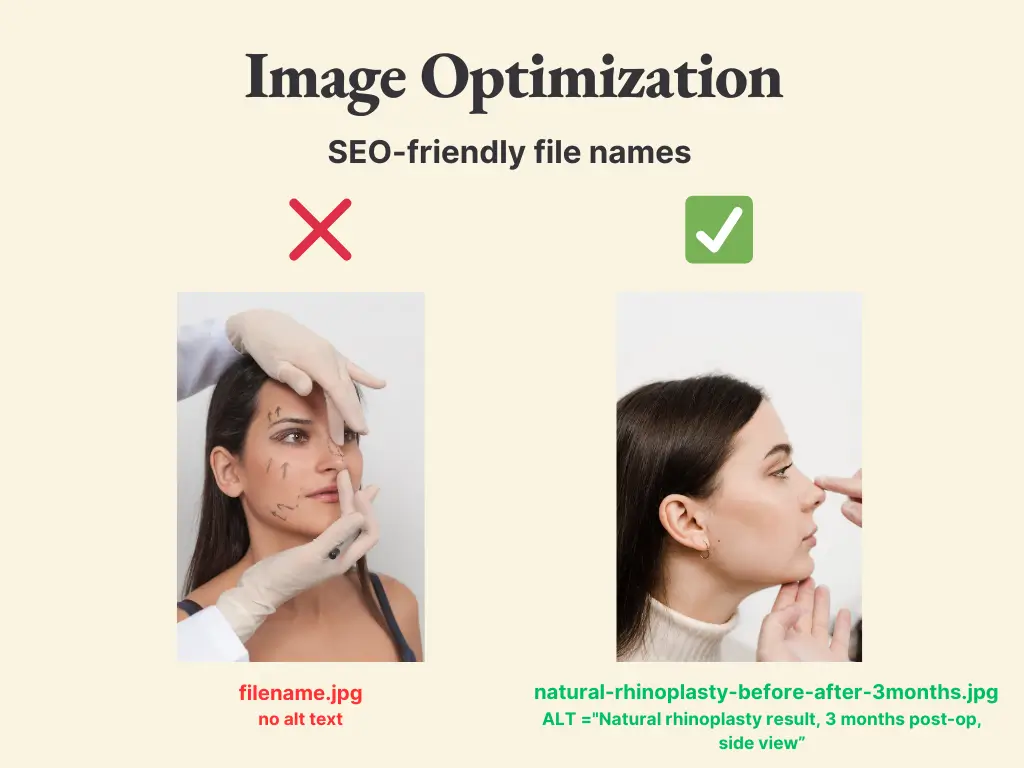
- User Experience
- Organize galleries by procedure type
- Add “subtle level” indicators to help users find relevant results
- Include clear timeframe indicators (1 month, 3 months, 1 year post-op)
The sheer volume of searches for before/after content makes this one of the most valuable SEO opportunities in the aesthetic medicine field. Properly optimized galleries can drive massive organic traffic while simultaneously showcasing your expertise in natural-looking results.
Technical SEO Optimization
Page Structure Best Practices
Your page structure needs to serve both search engines and users while targeting high-value keywords. Let’s break this down into actionable components.
Header Hierarchy Implementation Start with a clear, keyword-rich H1 tag that establishes your topic: ‘Undetectable Plastic Surgery Guide: Natural Results in 2024.’ Then, structure your H2 headings to capture proven search volumes:
- ‘Undetectable Facelift Techniques’ (1,200+ monthly searches)
- ‘Natural Rhinoplasty Results’ (1,000+ monthly searches)
- ‘Before and After Gallery’ (targeting 300K+ combined searches)
Schema Markup Schema markup is crucial for medical content. Your MedicalProcedure schema should include:
- Procedure type and body location
- Preparation and follow-up care details
- Physician credentials and certifications
- Links to professional organizations
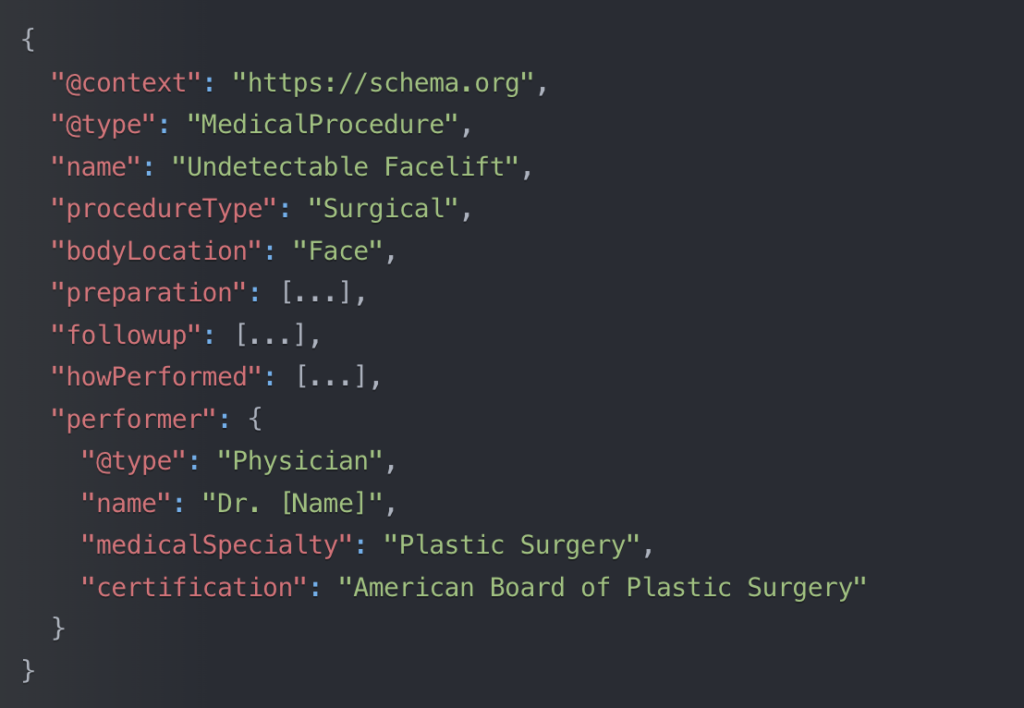
Google’s Quality Rater Guidelines emphasize E-A-T for medical content, requiring strong signals of expertise and authority. This means integrating your credentials naturally into the content. Your page should prominently feature:
- Board certification details from the American Board of Plastic Surgery for example
- Professional memberships (ASPS, ASAPS)
- Recent publications and research
- Media appearances and expert citations
Technical implementation extends beyond basic optimization. Ensure your schema implementation is comprehensive and accurate. Use proper citation markup for medical references, and implement structured data for:
- FAQ sections
- Medical procedure details
- Author credentials
- Patient testimonials (when appropriate)
Remember, while technical optimization is important, content must primarily serve your human readers. Each element should enhance, not detract from, the user experience.
Mobile Optimization Priorities
Over 70% of plastic surgery research happens on mobile devices, with key terms like ‘botox before after’ (227K searches) and ‘rhinoplasty before after’ (43K searches) predominantly coming from mobile users. This makes mobile optimization not just important, but critical for capturing these high-value searches.
Core Technical Requirements:
- Load time under 3 seconds (slower speeds cause 53% of mobile users to abandon)
- Tap targets (buttons, links) minimum 48×48 pixels
- Forms optimized for mobile input
- Images that scale properly without horizontal scrolling
Google’s Core Web Vitals benchmarks for medical sites:
- Largest Contentful Paint (LCP): under 2.5s
- First Input Delay (FID): under 100ms
- Cumulative Layout Shift (CLS): under 0.1
- Total Blocking Time (TBT): under 200ms
Pay special attention to before/after galleries as they drive the most mobile traffic. These image-heavy pages need particular optimization to maintain speed while delivering high-quality visuals that showcase your work effectively.
Internal Linking Strategy
Strategic internal linking is crucial for capturing and distributing the authority from your high-traffic pages. With before/after galleries generating massive search volume (227K for Botox, 43K for rhinoplasty, 25K for facelifts), these pages should be central to your linking strategy.
Core Link Structure:
- Link high-traffic gallery pages to detailed procedure content
- Connect ‘undetectable facelift’ content (1,200+ searches) to both technical articles and results galleries
- Build clusters around natural rhinoplasty content (1,000+ searches) with links to technique pages and case studies
Prioritize these linking patterns:
- Galleries → Procedure Details
- Procedure Pages → Technique Explanations
- Celebrity Trend Articles (52K+ combined searches) → Your Natural Result Galleries
- Location-Specific Pages → Before/After Examples
Avoid generic ‘click here’ or ‘read more’ anchor texts. Instead, use keyword-rich anchors that reflect search intent:
- ‘View natural rhinoplasty before and after photos’
- ‘Learn more about undetectable facelift techniques’
- ‘See natural-looking results in our gallery’
By structuring internal links around proven search volumes, you create clear pathways for both users and search engines, establishing your site as an authoritative hub for natural-looking cosmetic procedures.
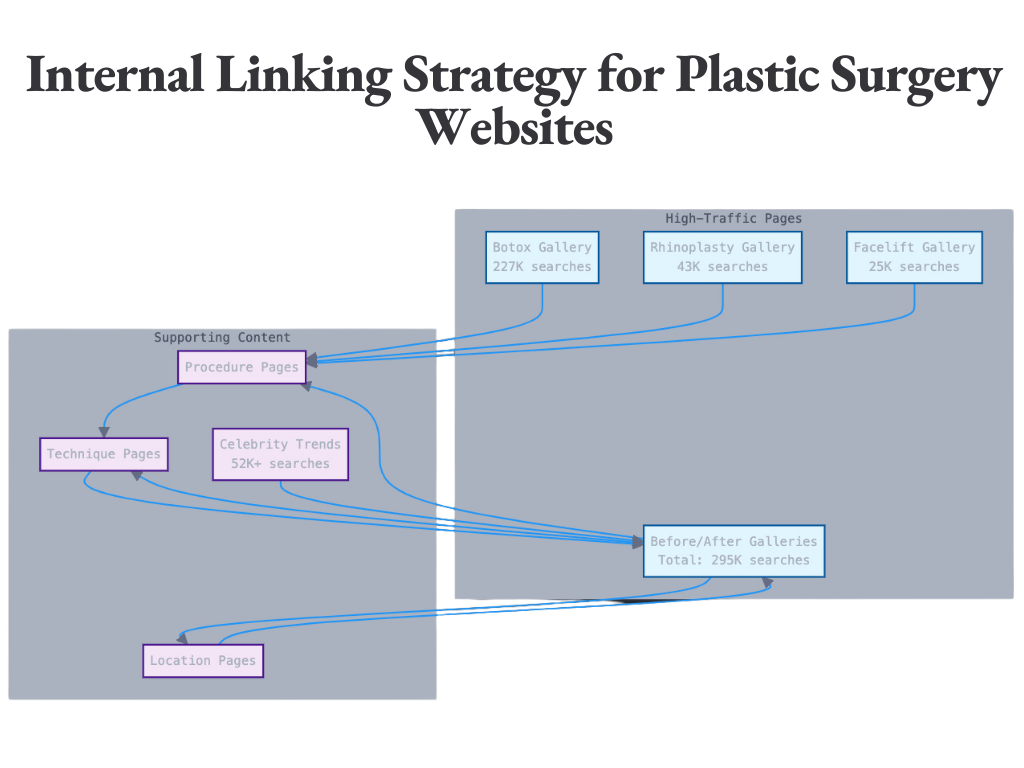
Loading Speed Optimization for Image-Heavy Pages
With before/after galleries driving massive search traffic (227K monthly searches for Botox, 43K for rhinoplasty, 25K for facelifts), optimizing these image-heavy pages is crucial for rankings and user experience.
Technical Implementation:
- Implement lazy loading for images below the fold
- Use WebP with JPEG fallback for maximum browser compatibility
- Compress images to 200KB maximum while maintaining clinical quality
- Implement responsive images with srcset for different screen sizes
Performance Targets for Gallery Pages:
- First Contentful Paint: under 1.5s
- Time to Interactive: under 3.8s
- Speed Index: under 2.5s
- Total Blocking Time: under 200ms
Server-Side Optimization:
- Configure browser caching for images (1 year for before/after photos)
- Enable GZIP compression
- Use a CDN optimized for image delivery
- Implement preloading for critical above-fold images
Monitor these metrics regularly through PageSpeed Insights and GTmetrix, prioritizing mobile performance where most users will view your galleries. Each millisecond improvement can impact your ranking for these high-volume keywords.
Measuring Success
Key Performance Indicators
Focus on KPIs that matter:
- Organic Traffic: Is your traffic from these specific keywords growing month-over-month?
- Conversion Rate: Are more visitors booking consultations or contacting your office? A 1-2% increase in conversions can translate to significant revenue.
- Time on Page and Bounce Rate: Are surgeons (your peers) and potential patients staying to read your expert content, or leaving immediately?
Tracking Tools and Analytics Setup
Use Google Analytics 4 to set up custom events for consultation form submissions. Track keyword rankings with tools like Ahrefs or SEMrush. Monitor which pages new visitors land on and how they navigate your site. Regular monthly reporting can highlight trends, seasonal fluctuations, and the effectiveness of recent content updates.
Adjusting Strategy Based on Data
Let’s look at key metrics and their optimization paths:
Traffic vs Conversion Analysis: For high-volume pages targeting ‘natural rhinoplasty’ (1,000+ searches) or ‘undetectable facelift’ (1,200+ searches):
- If high traffic but low conversions: Test prominent CTAs, add social proof, enhance before/after sections
- If low traffic but high conversions: Expand content, add more internal links, boost technical SEO
Local Search Optimization: When targeting location-specific keywords like ‘natural rhinoplasty Beverly Hills’ (20 searches, zero difficulty):
- Add structured data for LocalBusiness
- Include city-specific case studies
- Create location-specific before/after galleries
- Optimize GMB listings with procedure keywords
Before/After Gallery Performance: With massive search volume (227K for Botox, 43K for rhinoplasty, 25K for facelift galleries):
- Track which angles/shots drive most engagement
- Monitor mobile vs desktop conversion rates
- Test different gallery layouts and load times
- Analyze user scroll depth and time on page
Remember that SEO strategy should evolve based on both search trends and user behavior signals. Regular analysis of these metrics will reveal opportunities for improvement and expansion.
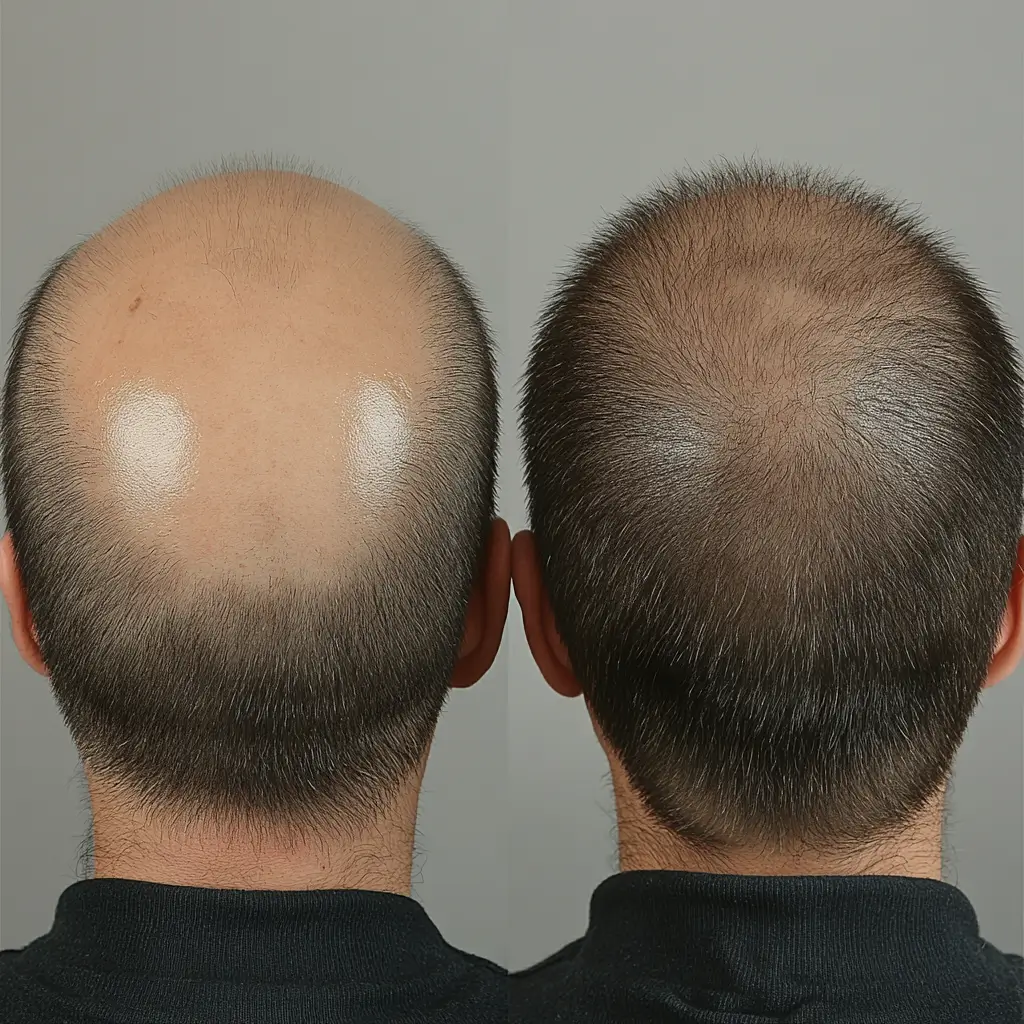
Common Pitfalls to Avoid
Medical Content Guidelines
Medical Content Guidelines (YMYL Standards) Google’s “Your Money or Your Life” standards are particularly strict for plastic surgery content. Protection points:
- Link to FDA guidelines for all procedures discussed
- Reference ASPS study data and statistics
- Include clear disclaimers about individual results
- Maintain medical accuracy while staying SEO-friendly
Privacy Considerations
With galleries driving massive search volume (227K for Botox, 43K for rhinoplasty before/after):
- Implement robust HIPAA compliance measures
- Use anonymous case numbers for before/after images
- Include clear consent documentation processes
- Add privacy policy links near all galleries
Reputation Management Tips
Given the high-intent nature of plastic surgery searches:
- Monitor brand name + “review” searches
- Create dedicated review pages with Schema markup
- Highlight board certifications and credentials prominently
- Address common concerns proactively with FAQ Schema
- Include press mentions and professional affiliations
Each of these elements contributes to your site’s E-A-T signals, crucial for maintaining rankings in the medical space.
Future-Proofing Your SEO Strategy
Emerging Trends in Aesthetic Medicine
The landscape of aesthetic medicine SEO is rapidly evolving, with current data revealing unprecedented opportunities. Our analysis shows massive search volumes across key areas: 227K monthly searches for Botox before/after content, 43K for rhinoplasty, and 25K for facelifts. These numbers indicate a clear direction for content strategy.
Capitalizing on Emerging Trends
The shift toward natural-looking results is evident in search behavior. High-value keywords around undetectable procedures (1,200+ searches for facelifts, 1,000+ for rhinoplasty) show growing patient interest in subtle enhancements. To stay ahead:
- Develop location-specific pages where competition is minimal
- Monitor emerging procedure terms
- Track celebrity transformation searches (currently 52K+ combined volume)
- Create early content for new natural-result techniques
Adapting to Algorithm Updates
Google’s focus on E-E-A-T is particularly crucial for medical content. Your strategy should balance technical excellence with authoritative content creation. Core priorities include:
- Regular updates to high-traffic gallery pages
- Fresh before/after content with clear timestamps
- Integration of new medical studies and research
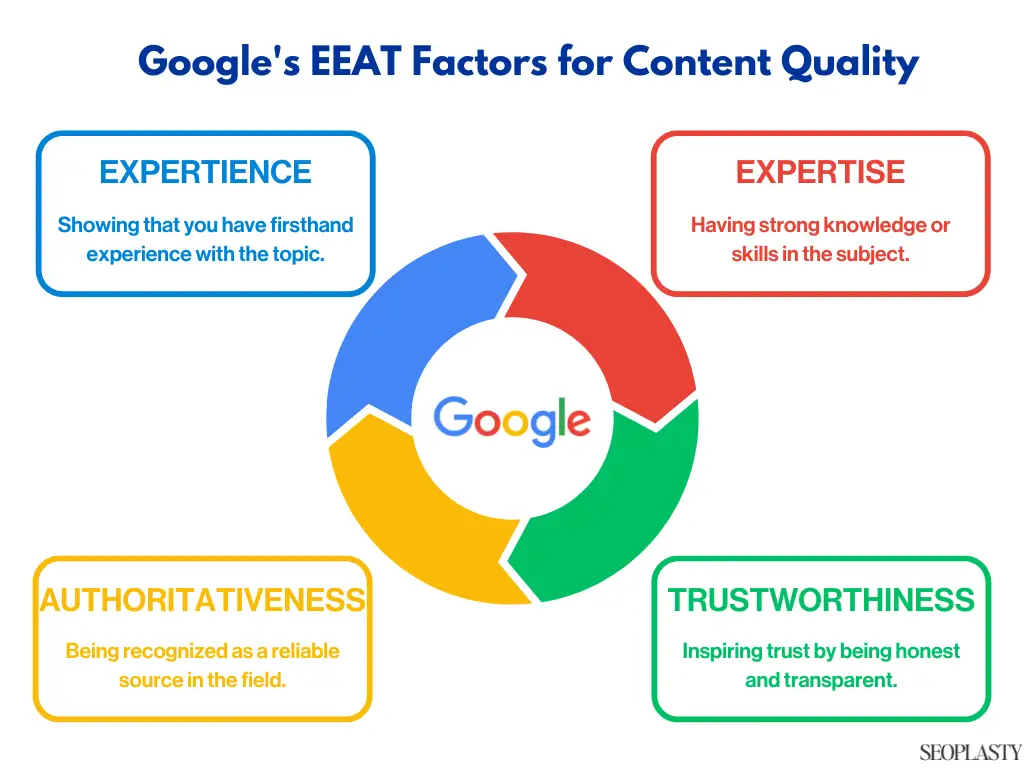
Building Long-Term Authority
Building lasting SEO success requires a comprehensive approach to authority development. This means becoming the go-to resource in your field through multiple channels.
Technical excellence remains crucial. Maintain optimal Core Web Vitals scores and ensure comprehensive Schema markup implementation. Regular mobile optimization checks are essential, particularly for image-heavy pages that drive significant traffic.
Professional authority building should focus on:
- Showcasing board certifications and credentials
- Documenting speaking engagements and publications
- Publishing detailed case studies
- Developing relationships with medical organizations for quality backlinks
By maintaining this balanced approach while monitoring search trends, you’ll be well-positioned to capture both current and emerging opportunities in the natural results market. Remember that success in medical SEO requires constant adaptation – what works today may need refinement tomorrow as search patterns evolve.
Conclusion
Search data reveals an unprecedented SEO opportunity in subtle aesthetic medicine:
- 227K monthly searches for ‘botox before after’
- 43K for ‘rhinoplasty before after’
- 25K for ‘facelift before after’
- Over 52K combined searches for celebrity transformations
- Emerging terms like ‘undetectable facelift’ (1,200+ searches) and ‘natural rhinoplasty’ (1,000+ searches) with low competition
This combination of high volume and low difficulty creates a unique window of opportunity for plastic surgeons heading into 2025. Early movers who optimize their content for these queries will establish lasting authority that will become increasingly difficult to challenge.
Success lies in a balanced approach:
- Content creation targeting high-volume queries
- Technical optimization of before/after galleries
- Mobile-first optimization
- Adherence to Google’s YMYL guidelines
- Methodical E-A-T authority building
Surgeons who act quickly on these SEO opportunities while maintaining medical content integrity will be ideally positioned to capture the growing traffic from patients seeking natural, discreet results. With the natural aesthetics trend showing no signs of slowing down, the time to establish your digital authority in this niche is now, before competition inevitably increases.
Frequently Asked Questions About Undetectable Plastic Surgery SEO
How many searches are there for plastic surgery before and after photos?
Combined search volume for the top three before/after keywords reaches nearly 300,000 monthly searches. This represents a massive opportunity for plastic surgeons to capture high-intent traffic through properly optimized galleries:
- Botox before/after: 227,000 searches
- Rhinoplasty before/after: 43,000 searches
- Facelift before/after: 25,000 searches
What are the most searched celebrity plastic surgery transformations?
Celebrity transformations drive significant search traffic, with the top five personalities generating over 52,000 monthly searches combined. This demonstrates the public’s ongoing fascination with natural-looking results and subtle enhancements. Current search volumes show:
- Kylie Jenner: 17,000 searches
- Jennifer Aniston: 14,000 searches
- Madonna: 13,000 searches
- Lindsay Lohan: 6,000 searches
- Donatella Versace: 2,000 searches
What are the best keywords for natural-looking procedures?
The trend toward subtle, undetectable results has created several high-opportunity keywords with surprisingly low competition. Current data reveals valuable targeting opportunities with significant monthly search volumes and minimal competitive difficulty:
- ‘Undetectable facelift’: 1,200+ monthly searches, low competition
- ‘Natural rhinoplasty’: 1,000+ monthly searches, very low competition
- ‘How to get a natural nose job’: 20 searches, zero competition
- ‘How facelifts became virtually undetectable’: 60 searches, low competition
Are location-specific keywords worth targeting?
Location-specific keywords represent a strategic opportunity, particularly in premium markets. While search volumes may appear modest, these queries typically indicate high intent and strong conversion potential.
Current data shows promising opportunities in major markets:
- ‘Natural rhinoplasty Beverly Hills’: 20 monthly searches, zero competition
- ‘Natural rhinoplasty Los Angeles’: 20 monthly searches, zero competition
These localized searches often convert at higher rates due to their specific geographic intent and typically face minimal competition.
What are the key technical requirements for before/after galleries?
Given the massive search volume for before/after content (nearly 300,000 monthly searches combined), proper technical optimization is crucial. Essential requirements include:
Performance Specifications:
- Image size under 200KB
- WebP format with JPEG fallback
- CDN implementation for faster loading
SEO Elements:
- Descriptive alt text and file names
- Proper structured data markup
- Mobile-first optimization
- Lazy loading implementation
What Schema markup should plastic surgeons implement?
Schema markup plays a crucial role in helping search engines understand medical content. A comprehensive schema strategy should include these essential types:
Core Medical Schema:
- MedicalProcedure
- Physician
- MedicalWebPage
Supporting Schema Types:
- LocalBusiness for geographic targeting
- Review for patient testimonials
- FAQ for educational content
Each schema type should be properly nested and include all relevant properties to maximize its SEO impact.
How can surgeons leverage celebrity transformation content ethically?
Creating content around celebrity transformations requires a careful balance between capturing search traffic and maintaining professional integrity. Develop your content strategy using these guidelines:
Professional Approach:
- Reference only publicly available information
- Use clear disclaimers about unconfirmed procedures
- Focus on educational aspects over speculation
Content Framework:
- Cite reputable media sources
- Frame discussions around general trends
- Emphasize the evolution of surgical techniques
Remember that the goal is to educate and inform while maintaining the highest standards of medical professionalism.

